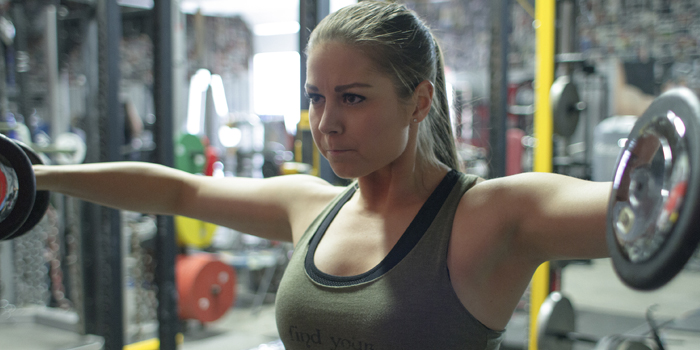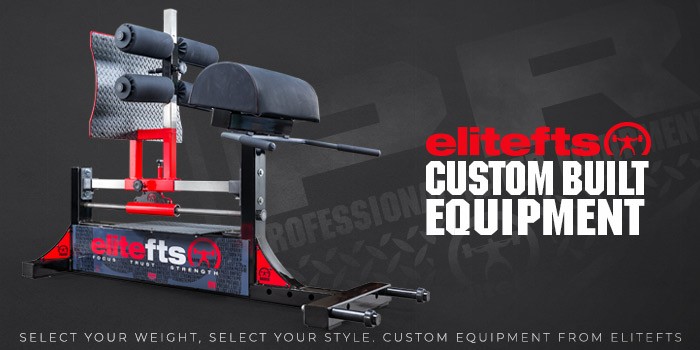
Tempo training is simply another tool in your toolbox that you can use to increase intensity and progressively overload your muscle. I have been experimenting with tempo training on my lower body days, as glute development is a huge focus for me this year. Below are some of my favorite tempo training exercises for glute development, but first, let’s talk about what tempo training is and how it can be utilized for building muscle size.
The Basics of Tempo Training
Tempo training refers to the speed of each rep, or more specifically, the speed of the concentric contraction (positive) and the speed of the eccentric contraction (negative) of a given exercise.
Experimenting with the speed of your reps on chosen exercises can elicit different effects on hypertrophy, hence why there are so many types and styles of tempo training.
But at the end of the day, the purpose of tempo training is to provide more time under tension, which is the driver of muscle hypertrophy in the first place, along with progressive overload.
There are many types of tempo training, but within this article, I am going to cover a few such isometric holds, slow eccentrics or negatives, and pulse reps (or quick concentrics.) I will also go into partial reps versus full ROM (range of motion) reps a bit, but for the point of this article, we will focus on tempo.
RECENT: Are You a Prius or a Ferrari?
Tempo Term Overview
- Isometric Contraction or Iso Hold: A muscle contraction where the muscle is neither shortening or lengthening.
- Eccentric Contraction/Negative/Down Phase: A muscle contraction in which the muscle is lengthening under load.
- Concentric Contraction/Positive/Up Phase: A muscle contraction in which the muscle is shortening under load.
It is important to understand these terms so you can also understand how some tempo exercises are written. I like to use the 4-point tempo style, as you will see in the last exercise. This style lays out the tempo for each part of the movement. For example, during a bicep curl, if we went with a 4-0-2-1 tempo that would refer to a 4-second eccentric (down phase or lowering of the dumbbell), 0-second hold at the bottom, 2-second concentric (up phase or raising of the dumbbell), and 1-second hold at the top. This style of tempo writing accounts for all pieces of the movement, not just the concentric/eccentric phases.
Let’s get to it! Below are my favorite tempo training exercises for glute development!
Partial Rep Iso Hold Hip Thrusts
I have been playing around with these specifically because I hated doing them for so long. I just never felt like I got a lot out of them at all, so I wanted to change that. They are a great exercise in theory, but whenever I performed a traditional or full range of motion hip thrusts, my quads would take over everything. They would be on fire, and I would have to end my set before my glutes even got fatigued.
When we think about the hip thrust from an anatomy standpoint, it makes sense that the quads will play a huge role during full ROM hip thrusts. Our quadriceps are a main flexor of the hip, and on the down phase of a hip thrust, our hips are supporting this weight during increased hip flexion. To avoid this, I started doing a partial range of motion reps that wouldn’t allow for as much hip flexion, and wouldn’t you know, my quads were completely relaxed the whole time. My glutes and hamstrings, which are equally as painful, drive the entire movement. But at least I am hitting what I want to hit. In this instance, the idea behind partial reps being more advantageous than full ROM reps is similar to exercises that hit smaller muscles, such as the rear delt, as well. The same concept can be applied with rear delts so your traps do not take over the movement.
I am still getting used to what weight I like best because even with only 135 pounds, I can get a solid squeeze and an isometric hold at the top without my low back firing up. I love adding the iso hold at the top because that is where the magic happens. Like I will note in my other exercise choices, if you want to grow your ass, you have to contract the muscle. I don’t go too much heavier because when I do, my low back will take over which defeats the purpose. For these, I did 10 partial reps, with a full second isometric hold at the top, for four sets. My glutes are always smoked afterward.
Dumbbell Pulse Split Squats
These are so freaking humbling. What I love about these is you can perform them with a higher weight lower rep scheme or a lower weight higher rep scheme, and they will do the job. During a split squat, you have your back foot elevated, which is very intentional for glute training. This position puts more emphasis on the glute (the front leg) versus a traditional split stance or a front foot elevated stance. I absolutely love the range of motion on these. So in this sequence, I simply did 10 more fast-paced reps, with 10 partial pulse-like reps immediately after, for a total of 20 reps per leg. If you want to go a bit heavier in weight, I would suggest doing six or so reps normal tempo, then finish with 10 partial pulse reps. They look so easy, but I assure you they are pretty intense. I love the partial pulses at the top because it puts so much tension on the glute alone.
Pulse style reps are typically deemed a “chick thing to do,” but try it and learn. When done properly, they are extremely effective. So don’t knock it until you try it! Here I did three sets of 20 each leg.
5-0-1-2 Tempo Rope Pull-Throughs
I really like doing these before my main lower body movement to get the hamstrings nice and warmed up and glutes fired up. You do not want to go too heavy on these, as the eccentric tempo is very slow. It is more of a controlled movement, really sitting into the stretch. I also like to add these first because it allows you to practice a posterior pelvic tilt at the top before getting into a heavier movement like a hip thrust.
A lot of folks do not practice a posterior pelvic tilt on a hip thrust, so they are really missing out on the benefits of that movement. Many folks hate flexing their glutes because it looks like shit, but that is how you build an ass, my friends. You don’t develop your glutes by keeping them relaxed the whole time. Like any muscle, you must contract them in order for them to grow.
What I also really love about rope pull-throughs is that the weight is coming from behind you on a cable, so when you pull, the force is consistent the whole time, compared to a dumbbell Romanian deadlift, that is not the case. So you never lose tension even at the top when using a cable. So for this movement, I did a 5-second eccentric/negative, 0 seconds at the bottom, 1-second concentric/positive, and 2-second hold at the top. I performed three sets of eight reps.
I would suggest that you perform these exercises on different days, except maybe the rope pull-throughs if you use those as a warm-up, reason being is even if you do them lightly, the tempo training will rip you up a bit if you do it all the time. I performed these all together for the sake of this article, but normally I spread them out. Yes, we want to encourage progressive overload, but especially with tempo training you may need more time to recover, so just keep that in mind. Go ahead and give these a whirl, and let me know how you like them!











1 Comment